Open Journal of Optimization
Vol.1 No.1(2012), Article ID:22386,7 pages DOI:10.4236/ojop.2012.11001
Roughly B-invex Multi-Objective Programming Problems
Department of Mathematics, Faculty of Science, Suez Canal University, Suez, Egypt
Email: drtema@yahoo.com
Received July 4, 2012; revised August 12, 2012; accepted August 31, 2012
Keywords: Multi-Objective Programming Problems; Roughly B-invex; Efficient Solutions; Properly Efficient Solutions
ABSTRACT
In this paper, we shall be interested in characterization of efficient solutions for special classes of problems. These classes consider roughly B-invexity of involved functions. Sufficient and necessary conditions for a feasible solution to be an efficient or properly efficient solution are obtained.
1. Introduction
The study of multi-objective programming problems was very active in recent years. The minimum (efficient, Pareto) solution is an important concept in mathematical models, economics, decision theory, optimal control and game theory (see, for example, [1]). In most works, an assumption of convexity was made for the objective functions. Very recently, some generalized convexity has received more attention (see, for example, [2-6]). A significant generalization of convex functions is invex function introduced first by Hanson [7], which has greatly been applied in nonlinear optimization and other branches of pure and applied sciences.
The concept of B-invex functions was proposed by [8] as generalization of convex functions; these functions were extended to quasi B-invex, and pseudo B-invex functions. Many functions seem to be B-invex, but they are not, and many non B-invex functions are able to get B-invex by choosing a suitable condition. Based on the previous discussion, Tarek [9] introduced a new class of B-invex functions, this class called roughly B-invex functions.
Inspired and motivated by above works, the purpose of this paper is to formulate a multi-objective programming problem which it involves roughly B-invex functions. An efficient solution for considered problem is characterized by weighting and ε-constraint approaches. In the end of the paper, we obtain sufficient and necessary conditions for a feasible solution to be an efficient or properly efficient solution for this kind of problems. Let us survey, briefly, the definitions and some results of roughly B-invexity.
Definition 1 [10]
Let . The set M is said to be B-invex with respect to
. The set M is said to be B-invex with respect to  at
at  if there exists
if there exists
 such that
such that , for each
, for each , and
, and .
.
M is said to be B-invex set with respect to η if M is B-invex at each  with respect to the same η.
with respect to the same η.
Note that, as in convex set, the intersection of finite (or infinite) family of B-invex sets is B-invex but the union is not necessarily B-invex set. Also, the sum of B-invex sets and the multiplying a B-invex set by a real number are again B-invex sets. Every B-invex set with respect to  is an invex set when b = 1; but the converse is not necessarily true.
is an invex set when b = 1; but the converse is not necessarily true.
Definition 2 [9]
A numerical function f , defined on a B-invex subset M of Rn, is said to be roughly B-invex with respect to  with roughness degree r at
with roughness degree r at  if there exists
if there exists , such that
, such that
 for each
for each , and
, and  such that
such that .
.
f is said to be roughly B-invex on M with respect to  if it is roughly B-invex at each
if it is roughly B-invex at each  with respect to the same
with respect to the same .
.
Every invex function, with respect to η is roughly B-invex function with respect to same η, where b (x, y) = 1; but the converse is not necessarily true. If the functions  are all roughly B-invex with respect to
are all roughly B-invex with respect to  with roughness degree
with roughness degree  on a B-invex set
on a B-invex set , then the function
, then the function

is roughly B-invex with respect to same η with roughness degree

on M for ai ≥ 0. If  is roughly B-invex with respect to
is roughly B-invex with respect to  with roughness degree r, on B-invex set
with roughness degree r, on B-invex set , then for any real number
, then for any real number  the level set
the level set  is B-invex set. A numerical function f defined on a B-invex set
is B-invex set. A numerical function f defined on a B-invex set  is roughly B-invex function with respect to
is roughly B-invex function with respect to  with roughness degree r if and only if epi(f) is a B-invex set. If
with roughness degree r if and only if epi(f) is a B-invex set. If  is a family of numerical functions, which are roughly B-invex with respect to
is a family of numerical functions, which are roughly B-invex with respect to  with roughness degree r and bounded from above on a B-invex set
with roughness degree r and bounded from above on a B-invex set , then the numerical function
, then the numerical function

is a roughly B-invex with respect to same η with roughness degree r on M. If  is a differentiable roughly B-invex function with respect to
is a differentiable roughly B-invex function with respect to  with roughness degree r, at
with roughness degree r, at , then there exists a function
, then there exists a function , such that
, such that
 for each
for each  such that
such that .
.
Definition 3 [9]
A numerical function f, defined on a B-invex subset M of Rn, is said to be quasi roughly B-invex with respect to  with roughness degree r at
with roughness degree r at , if there exists
, if there exists , such that
, such that
 for each
for each , and
, and  such that
such that .
.
f is said to be quasi roughly B-invex on M with respect to  if it is roughly B-invex at each
if it is roughly B-invex at each  with respect to the same
with respect to the same .
.
A  is quasi roughly B-invex with respect to η: M × M → Rn with roughness degree r, on
is quasi roughly B-invex with respect to η: M × M → Rn with roughness degree r, on , if and only if the level set
, if and only if the level set

is B-invex set. A roughly B-invex function, with respect to  with roughness degree r is quasi roughly B-invex function with respect to same η with roughness degree r. Let
with roughness degree r is quasi roughly B-invex function with respect to same η with roughness degree r. Let  be B-invex set, if
be B-invex set, if  is differentiable quasi roughly B-invex with respect to
is differentiable quasi roughly B-invex with respect to  with roughness degree r, at
with roughness degree r, at , then there exists a function
, then there exists a function , such that
, such that
 for each
for each  such that
such that .
.
Definition 4 [9]
A numerical function f, defined on a B-invex subset M of Rn, is said to be pseudo roughly B-invex with respect to  with roughness degree r at
with roughness degree r at , if there exists
, if there exists , and, there exists a strictly positive function a: Rn × Rn → R such that
, and, there exists a strictly positive function a: Rn × Rn → R such that

for each  such that
such that .
.
If  is roughly B-invex function with respect to
is roughly B-invex function with respect to  with roughness degree r on B-invex set
with roughness degree r on B-invex set , then f is pseudo roughly B-invex function with respect to same η with roughness degree r on M. Let
, then f is pseudo roughly B-invex function with respect to same η with roughness degree r on M. Let  be B-invex set and
be B-invex set and  be a differentiable pseudo roughly B-invex with respect to
be a differentiable pseudo roughly B-invex with respect to with roughness degree r, at
with roughness degree r, at , then there exists a function
, then there exists a function , such that
, such that
 for each
for each  such that
such that .
.
2. Problem Formulation
Let , and
, and  i = 1, 2, ···, m are real valued roughly B-invex functions on Rn. A roughly B-invex multi-objective programming problem is formulated as follows:
i = 1, 2, ···, m are real valued roughly B-invex functions on Rn. A roughly B-invex multi-objective programming problem is formulated as follows:
(P) 
Definition 5 [11]
A feasible solution x for (P) is said to be an efficient solution for (P) if and only if there is no other feasible x for (P) such that, for some ,
,
 .
.
Definition 6 [11]
An efficient solution  for (P) is a properly efficient solution for (P) if there exists a scalar
for (P) is a properly efficient solution for (P) if there exists a scalar  such that for each
such that for each , and each
, and each  satisfying
satisfying , there exists at least one
, there exists at least one  with
with  and
and
 .
.
Lemma 1 [9]
If  is roughly B-invex with respect to
is roughly B-invex with respect to  with roughness degree r, on Rn, i = 1, 2, ···, m, then the set
with roughness degree r, on Rn, i = 1, 2, ···, m, then the set

is B-invex set.
Lemma 2 [9]
If  is quasi roughly B-invex with respect to
is quasi roughly B-invex with respect to  with roughness degree r, on Rn, i = 1, 2, ···, m, then the set
with roughness degree r, on Rn, i = 1, 2, ···, m, then the set

is B-invex set.
Lemma 3
Let . If
. If is a roughly B-invex function with respect to
is a roughly B-invex function with respect to  with roughness degree r on a B-invex set
with roughness degree r on a B-invex set , then the set
, then the set
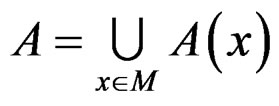 is convexwhere
is convexwhere .
.
Proof. Let  then for
then for  and
and  we have
we have
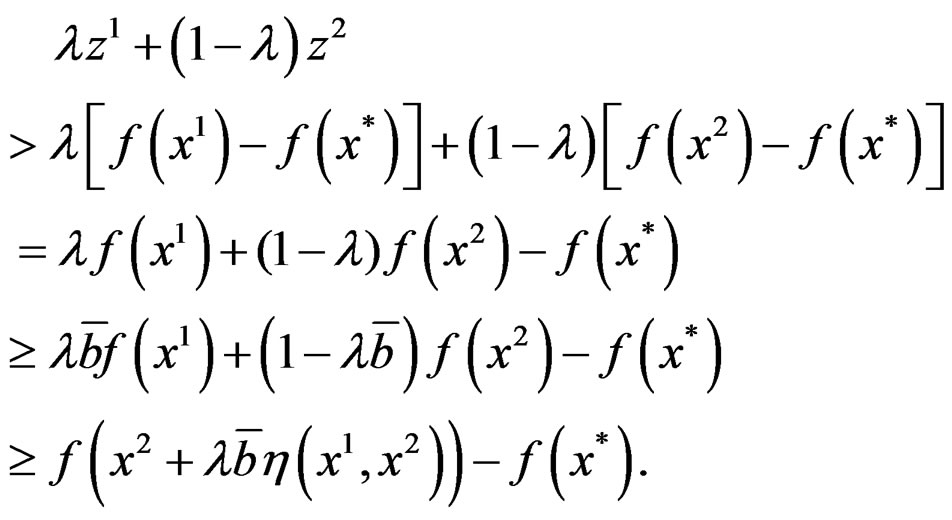
Since f is a roughly B-invex function on a B-invex set M. Then , and hence A is convex set.
, and hence A is convex set.
For a feasible point , we denote
, we denote  as the index set for binding constraints at x*, i.e.,
as the index set for binding constraints at x*, i.e., .
.
3. Characterizing Efficient Solutions by Weighting Approach
To characterizing an efficient solution for problem (P) by weighting approach [11] let us scalarize problem (P) to become in the form.
(Pw) 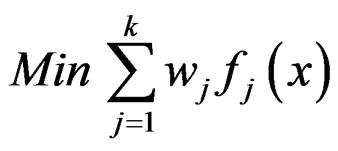 , s.t.
, s.t. where
where 
and , j = 1, 2, ···, k are roughly B-invex with respect to
, j = 1, 2, ···, k are roughly B-invex with respect to  with roughness degree rj on B-invex set M.
with roughness degree rj on B-invex set M.
Theorem 1
If  is an efficient solution for problem (P), then there exist
is an efficient solution for problem (P), then there exist

such that  is an optimal solution for problem (Pw).
is an optimal solution for problem (Pw).
Proof. Let  be an efficient solution for problem (P), then the system
be an efficient solution for problem (P), then the system  j = 1, 2, ···, k has no solution
j = 1, 2, ···, k has no solution . Upon Lemma 3 and by applying the generalized Gordan theorem [12], there exist
. Upon Lemma 3 and by applying the generalized Gordan theorem [12], there exist  such that
such that
 and
and  .
.
Denote 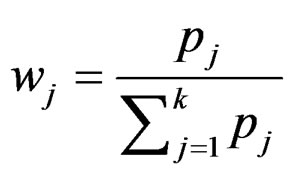 then
then  and
and  .
.
Hence  is an optimal solution for problem (Pw).
is an optimal solution for problem (Pw).
Theorem 2
If  is an optimal solution for
is an optimal solution for  corresponding to
corresponding to , then
, then  is an efficient solution for problem (P) if either one of the following two conditions holds:
is an efficient solution for problem (P) if either one of the following two conditions holds:
(i)  for all
for all ; or (ii)
; or (ii)  is the unique solution of
is the unique solution of .
.
Proof. To proof see V. Chankong, Y. Y. Haimes [11].
4. Characterizing Efficient Solutions by ε-Constraint Approach
An ε-constraint approach is one of the common approaches for characterizing efficient solutions of multiobjective programming problems [11]. In the following we shall characterizing an efficient solution for multiobjective roughly B-invex programming problem (P) in term of an optimal solution of the following scalar problem.

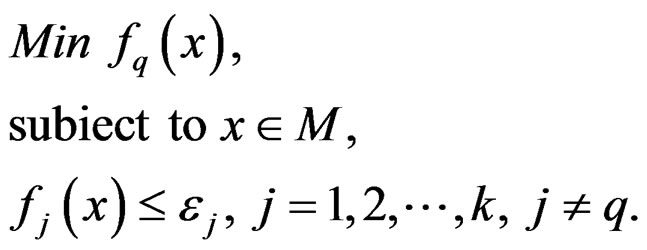
where  are roughly B-invex with respect to
are roughly B-invex with respect to  with roughness degree rj on B-invex set M.
with roughness degree rj on B-invex set M.
Theorem 3
If  is an efficient solution for problem (P), then
is an efficient solution for problem (P), then  is an optimal solution for problem
is an optimal solution for problem  corresponding to
corresponding to .
.
wang#title3_4:spProof.
Let  be not optimal solution for
be not optimal solution for  where
where  So there exists
So there exists 
such that  ,
,
 .
.
Thus,  is inefficient solution for problem (P) which is a contradiction. Hence
is inefficient solution for problem (P) which is a contradiction. Hence  is an optimal solution for problem
is an optimal solution for problem .
.
Theorem 4
Let  is an optimal solution of
is an optimal solution of  for all q = 1, 2, ···, k, where
for all q = 1, 2, ···, k, where , j = 1, 2, ···, k . Then
, j = 1, 2, ···, k . Then  is an efficient solution for problem (P).
is an efficient solution for problem (P).
wang#title3_4:spProof.
Since  is an optimal solution for
is an optimal solution for , for all q = 1, 2, ···, k. So, for each
, for all q = 1, 2, ···, k. So, for each , we get
, we get  q = 1, 2, ···, k.
q = 1, 2, ···, k.
This implies that the system  j = 1, 2, ···, k has no solution
j = 1, 2, ···, k has no solution , i.e.
, i.e.  is an efficient solution for problem (P).
is an efficient solution for problem (P).
5. Sufficient and Necessary Conditions for Efficiency
In this section, we discuss the sufficient and necessary conditions for a feasible solution x* to be efficient or properly efficient for problem (P) in the form of the following theorems.
Theorem 5
Suppose there exists a feasible solution x* for (P), and scalars , such that
, such that
 . (1)
. (1)
If , j = 1, 2, ···, k are roughly B-invex with respect to
, j = 1, 2, ···, k are roughly B-invex with respect to  with roughness degree r at x* and gi,
with roughness degree r at x* and gi,  is roughly B-invex with respect to same η with roughness degree ri at x*. Then x* is a properly efficient solution for problem (P).
is roughly B-invex with respect to same η with roughness degree ri at x*. Then x* is a properly efficient solution for problem (P).
Proof.
Since , j = 1, 2, ···, k and
, j = 1, 2, ···, k and 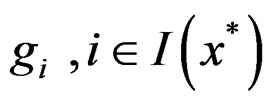 are roughly B-invex with respect to same η, then there exists a function
are roughly B-invex with respect to same η, then there exists a function 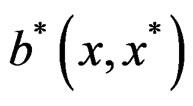 such that
such that

by (1) for each  such that
such that
 .
.
Thus,  for all
for all , which implies that x* is the minimizer of
, which implies that x* is the minimizer of
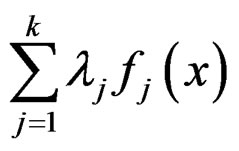
such that 
under the constraint  where
where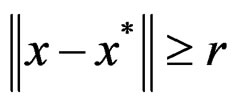 . Hence, from Theorem (4.11) of [11], x* is a properly efficient solution for problem (P).
. Hence, from Theorem (4.11) of [11], x* is a properly efficient solution for problem (P).
Theorem 6 Let x* be a feasible solution for (P). If there exist scalars ,
,
 such that the triplet (x*, wi, ui) satisfies (1) of Theorem (5),
such that the triplet (x*, wi, ui) satisfies (1) of Theorem (5),
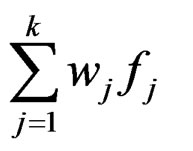
is strictly roughly B-invex with respect to η: M × M → Rn with roughness degree r at x* and gi, 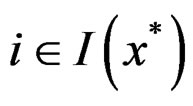 is roughly B-invex with respect to same η with roughness degree ri at x*. Then x* is an efficient solution for problem (P).
is roughly B-invex with respect to same η with roughness degree ri at x*. Then x* is an efficient solution for problem (P).
Proof.
Suppose that x* is not an efficient solution for (P). Then, there exists a feasible , and index v such that
, and index v such that 

Since 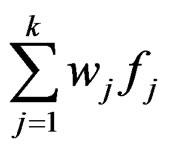
is strictly roughly B-invex with respect to η with roughness degree r at x*, then there exists a function 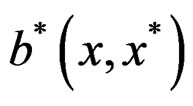 such that
such that
 . (2)
. (2)
Also, roughly B-invexity of gi, 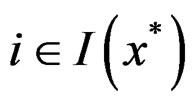 with respect to same η at x* with roughness degree ri implies
with respect to same η at x* with roughness degree ri implies
 i.e.
i.e.  , (3)
, (3)
such that . Adding (2) and (3), contradicts (1). Hence, x* is an efficient solution for problem (P).
. Adding (2) and (3), contradicts (1). Hence, x* is an efficient solution for problem (P).
Remark 1
Similarly as in Theorem (5), it can be easily seen that x* becomes properly efficient solution for (P), in the above theorem, if wj > 0, for all j = 1, 2, ···, k.
Theorem 7
Suppose there exists a feasible solution x* for (P), and scalars wi > 0, j = 1, 2, ···, k,  such that (1) of Theorem (5) holds. If
such that (1) of Theorem (5) holds. If
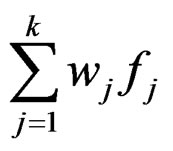
is pseudo roughly B-invex with respect to  with roughness degree r at x* and gI is quasi roughly B-invex with respect to same η with roughness degree rI at x*. Then x* is a properly efficient solution for problem (P).
with roughness degree r at x* and gI is quasi roughly B-invex with respect to same η with roughness degree rI at x*. Then x* is a properly efficient solution for problem (P).
Proof.
Since , and gI are quasi roughly B-invex with respect to η with roughness degree rI at
, and gI are quasi roughly B-invex with respect to η with roughness degree rI at , then there exists a function
, then there exists a function 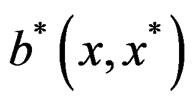 such that
such that
 for all
for all  such that
such that . By using (1)we have
. By using (1)we have 
which implies
 since
since 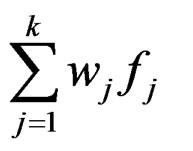
is pseudo roughly B-invex with respect to same η with roughness degree r at x* which implies that x* is the minimizer of

such that 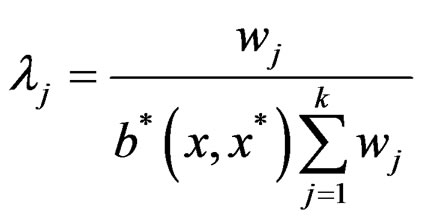
under the constraint  where
where 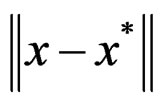 ≥ max(r, ri). Therefore, x* is a properly efficient solution for problem (P).
≥ max(r, ri). Therefore, x* is a properly efficient solution for problem (P).
Theorem 8
Suppose that there exist a feasible solution x* for (P) and scalars ,
,
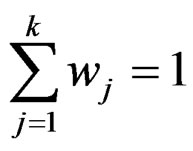 ,
,  such that (1) of Theorem (5) holds. Let
such that (1) of Theorem (5) holds. Let
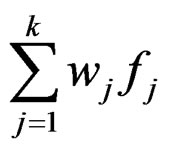
be strictly pseudo roughly B-invex with respect to  with roughness degree r at
with roughness degree r at  and gI be quasi roughly B-invex with respect to same η with roughness degree rI at x*. Then x* is an efficient solution for problem (P).
and gI be quasi roughly B-invex with respect to same η with roughness degree rI at x*. Then x* is an efficient solution for problem (P).
Proof. Suppose that x* is not an efficient solution for (P).Then, there exists a feasible x for (P), and index v such that  then there exists a function
then there exists a function 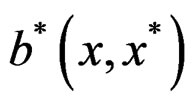 such that,
such that,
 Strictly pseudo roughly B-invexity of
Strictly pseudo roughly B-invexity of 
implies that 
for all  such that
such that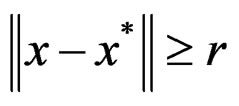 . Since gI is quasi roughly B-invex with respect to same η with roughness degree rI at
. Since gI is quasi roughly B-invex with respect to same η with roughness degree rI at  and
and then
then  for all
for all  such that
such that
 .
.
The proof now similar to the proof of Theorem (6).
Remark 2
Similarly as in Theorem (7), it can be easily seen that x* becomes properly efficient solution for (P), in the above theorem, if .
.
Theorem 9
Suppose there exists a feasible solution x* for (P), and scalars  such that (1) of Theorem (5) holds. Let
such that (1) of Theorem (5) holds. Let

be pseudo roughly B-invex with respect to  with roughness degree
with roughness degree  at x* and
at x* and  be quasi roughly B-invex with respect to same η with roughness degree
be quasi roughly B-invex with respect to same η with roughness degree  at x*. Then x* is a properly efficient solution for problem (P).
at x*. Then x* is a properly efficient solution for problem (P).
Proof. The proof is similar to the proof of Theorem (7).
Theorem 10
Suppose that there exist a feasible solution x* for (P) and scalars ,
,
 such that (1) of Theorem (5) holds. If
such that (1) of Theorem (5) holds. If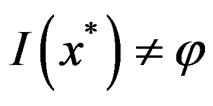 ,
,
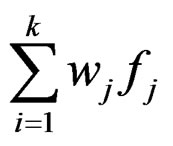
is quasi roughly B-invex with respect to  with roughness degree r at x* and
with roughness degree r at x* and  is strictly pseudo roughly B-invex with respect to same η with roughness degree rI at x*. Then x* is an efficient solution for problem (P).
is strictly pseudo roughly B-invex with respect to same η with roughness degree rI at x*. Then x* is an efficient solution for problem (P).
Proof. The proof is similar to the proof of Theorem (8).
Remark 3
Similarly as in Theorem (7), it can be easily seen that x* becomes properly efficient solution for (P), in the above theorem, if .
.
Theorem 11 (Necessary Optimality Criteria)
Assume that x* is a properly efficient solution for problem (P). Assume also that there exist a feasible point  for (P) such that
for (P) such that , and each
, and each 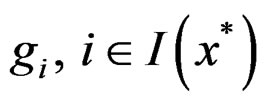 is roughly B-invex with respect to η: M × M → Rn with roughness degree ri at x*. Then, there exists scalars
is roughly B-invex with respect to η: M × M → Rn with roughness degree ri at x*. Then, there exists scalars  and
and , such that the triplet
, such that the triplet 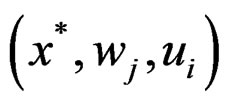 satisfies
satisfies
 . (4)
. (4)
Proof. Let the following system
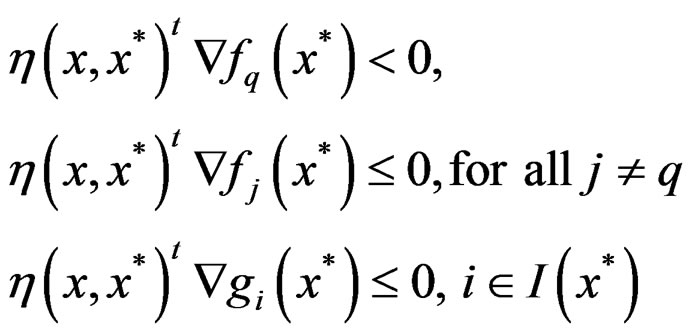 . (5)
. (5)
has a solution for every . Since by the assumed Slater-type condition,
. Since by the assumed Slater-type condition,
 and then from roughly Bi-invexity of gi at
and then from roughly Bi-invexity of gi at  with respect to η, there exists a function
with respect to η, there exists a function 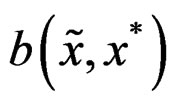 such that
such that
 . (6)
. (6)
Therefore from (5) and (6)
 for all
for all . Hence for some positive λ small enough
. Hence for some positive λ small enough

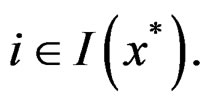
Similarly, for , and for
, and for  small enough
small enough
 .
.
Thus, for λ sufficiently small and all

is feasible for problem (P). For sufficiently small , (5) gives
, (5) gives
 . (7)
. (7)
Now, for all  such that
such that
 (8)
(8)
Consider the ratio (see Equation (9))
From (5), . Similarly,
. Similarly, ; but, by (8)
; but, by (8) .
.
Thus, the ratio in (9) becomes unbounded, contradicting the proper efficiency of x* for (P). Hence, for each q = 1, 2, ···, k, the system (5) has no solution. The result then follows from an application of the Farkas Lemma as in [12], namely
 .
.
Theorem 12
Assume that x* is an efficient solution for problem (P) at which the Kuhn-Tucker constraint qualification is satisfied. Then, there exist scalars
 ,
, such that
such that
 ,
,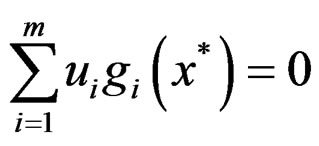 .
.
Proof.
Since every efficient solution is a weak minimum, then by applying Theorem (2.2) of Weir and Mond [13] for x*, we get, there exists  such that
such that

 . (9)
. (9)
 , where
, where .
.
REFERENCES
- B. D. Craven, “Control and Optimization,” Chapman and Hall, London, 1995.
- H. X. Phu, “Six Kind of Roughly Convex Functions,” Journal of Optimization Theory and Applications, Vol. 92, No. 2, 1997, pp. 357-375. doi:10.1023/A:1022611314673
- S. K. Mishra, S. Y. Wang and K. K. Lai, “Generalized Convexity and Vector Optimization, Nonconvex Optimization and Its Applications,” Springer-Verlag, Berlin, 2009.
- S. K. Mishra and G. Giorgi, “Invexity and Optimization, Nonconvex Optimization and Its Applications,” SpringerVerlag, Berlin, 2008.
- S. K. Suneja, S. Khurana and Vani, “Generalized Nonsmooth Invexity over Cones in Vector Optimization,” European Journal of Operational Research, Vol. 186, No. 1, 2008, pp. 28-40. doi:10.1016/j.ejor.2007.01.047
- S. Komlosi, T. Rapesak and S. Schaible, “Generalized Convexity,” Springer-Verlag, Berlin, 1994.
- M. A. Hanson, “On Sufficiency of the Kuhn-Tucker Conditions,” Journal of Mathematical Analysis and Applications, Vol. 80, No. 2, 1981, pp. 545-550. doi:10.1016/0022-247X(81)90123-2
- C. R. Bector, S. K. Sunela and C. Singh, “Generalization of Preinvex and B-vex Functions,” Journal of Optimization Theory and Applications, Vol. 76, No. 3, 1993, pp. 277-287. doi:10.1007/BF00939383
- T. Emam, “Roughly B-invex Programming Problems,” Calcolo, Vol. 48, No. 2, 2011, pp. 173-188. doi:10.1007/s10092-010-0034-5
- T. Morsy, “A Study on Generalized Convex Mathematical Programming Problems, Master Thesis, Faculty of Science,” Suez Canal University, Egypt, 2003.
- V. Chankong and Y. Y. Haimes, “Multiobjective Decision Making Theory and Methodology,” North-Holland, Amsterdam, 1983.
- M. S. Bazaraa and C. M. Shetty, “Nonlinear Programming-Theory and Algorithms,” John Wiley and Sons, Inc., New York, 1979.
- T. Weir and B. Mond, “Generalized Convexity and Duality in Multiple Objective Programming,” Bulletin of the Australian Mathematical Society, Vol. 39, No. 2, 1989, pp. 287-299. doi:10.1017/S000497270000277X

